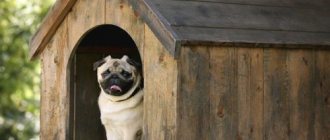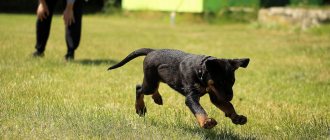The three main situations in which a four-legged friend has to wear a muzzle include the following examples: to avoid attacks on passers-by while walking, for examination by a veterinarian, and to prevent the dog from grabbing everything from the ground. At least two of them are directly related to the health of the pet. After all, the doctor examines an aggressive dog, not accustomed to wearing a muzzle, much less carefully, distracted by ensuring that the patient does not bite him.
Protected by such a piece of clothing, the dog does not risk getting poisoned by accidentally eating a piece of isoniazid-soaked sausage on the street, and people you meet on a walk are calmer when they see that the animal is wearing such an accessory. The article will talk about how to accustom a dog to a muzzle, when to start training and what mistakes it is better not to make in the training process.
Types of muzzles
Plastic
The model is made of plastic intertwined rods. The product is lightweight and quite durable.
After a walk, the plastic can be easily washed off from dirt. Due to the wide rods and the space free from the mouth (if the size is chosen correctly), the dog can easily open its mouth, which is very important for cooling the body in case of overheating.
The model will prevent the animal from trying to pick up something from the ground.
You should be careful when using a plastic product in winter, when exposed to frost: the material may crack.
The model is suitable for dogs of small, medium and large breeds.
Leather
The product consists of intertwined leather rods in the form of a mesh, which are secured to each other using metal inserts.
The model is predominantly light, due to which the dog is not only more comfortable using it, but also on walks, especially if the pet is not overly careful; in case the dog bumps into your legs or touches your legs with its muzzle, the product will not cause you additional pain.
In such equipment, the dog will not be able to pick up anything from the ground. The leather model is durable.
Such a thing requires some care, otherwise the model will become stiff and unusable.
Also, when washing leather, you will need to dry it, unlike plastic or metal materials, which can simply be wiped with a dry cloth.
The leather model is suitable for pets of large and medium breeds.
Metal
The model is made of iron intertwined rods in the form of a mesh.
This product is very durable. The dog will not be able to pick up anything from the ground wearing such equipment. Also, the animal can easily open its mouth, and in the heat it will not be difficult for it due to this.
The product is quite heavy, and therefore your pet can hurt you if it accidentally bumps into you and hits you with its muzzle.
After a walk, the metal can be easily washed and wiped with a rag. The model is suitable for dogs of large and medium breeds.
Fabric
The model is a sewn nylon fabric that fits tightly to the dog's face. The nose and the space around it remain open.
Fabric ammunition is very light.
Since the pet cannot open its mouth with this product, it is highly not recommended to use it in the heat or give the animal physical activity - this is fraught with bad consequences.
It will be difficult for your pet to pick something up from the ground, but it is possible. The dog can at least lick the edible food. Such ammunition is not durable. After walking and washing the product, you will have to dry it.
The model is suitable for dogs of small, large and medium breeds.
Halter
The model consists of several sewn fabric strips with a ring for attaching a leash.
Such ammunition is not suitable for aggressive dogs or animals that have problems picking up from the ground, since the pet will be able to easily move its mouth in it.
The halter is adapted to attach a leash to it; the dog, due to the design of the product, stops pulling and walks on a sagging leash.
The model is difficult to get dirty, but after a walk it can be washed with water and needs to be dried.
The halter is suitable for dogs of medium and large breeds.
Overcoming fear in a puppy
Remember the main rule: the animal should associate the muzzle exclusively with positive (to begin with) or at least neutral things. Putting a muzzle on to punish an animal is strictly prohibited!
It is equally important to choose the right accessory that is comfortable to wear. It should not rub the muzzle, press or pull. Each muzzle has its own pros and cons, so it’s better to have several for different situations:
Plastic – lightweight, convenient for training, has no foreign odors. But it is not durable in everyday wear.
Iron is very reliable, but is absolutely not suitable for frost. It can cause bruises for the owner if a large animal begins to poke its muzzle into your legs.
Nylon – often chafes and is generally uncomfortable for the dog. It is difficult to open its mouth, breathe, etc.
Closed or open leather - interferes with the animal's normal cooling and is not suitable for regular training. If you save on a leather accessory, your dog will easily bite through it. But muzzles made of high-quality leather are just as reliable as metal ones.
If you accustom your pet to one type of muzzle, then there will be no problems with others, you just need to give it a couple of days to get used to it.
How to choose the right model
The pet supply market offers a wide range of products to suit every taste. For each pet, ammunition is selected individually, taking into account a variety of details: the size of the pet, the purpose of purchase (dog aggression, protection from being picked up from the ground, travel in public places, and so on), wear resistance.
- If your pet has aggression towards other animals or people, you should purchase a durable closed model that fits well on the animal's face. Metal, leather and plastic products are suitable.
- If your pet has problems picking up from the ground, closed models are suitable: plastic, leather or metal.
- If you need to purchase a muzzle in order for you and your dog to be allowed into public places and transport, you can purchase a halter. In fact, this thing is a muzzle, so you are not violating any prohibitions by using it. In addition, the pet will be comfortable in this accessory.
- For a trip to the veterinarian, you can purchase a nylon model. This item is not suitable for everyday use, but for such situations its use will come in handy.
From what age?
According to the law, you can walk with a puppy without a muzzle for up to 3 months. But it’s better to really start accustoming your baby to this accessory from 5 months or even six months - if you have a large breed. For other breeds, it is generally better to wait until 7-8 months.
Until this time, any exit to the street is already stressful for him, and an incomprehensible piece of iron on his face will increase this stress significantly. If you miss this time, or get a dog that is already mature and untrained, don’t worry : the training technique at any age is not very different.
Advice! There is also no need to rush with a muzzle because puppies grow very quickly. An accessory that is not the right size will be inconvenient for the animal and will set it in a negative mood. And changing the muzzle every month and a half will be expensive.
How to determine the correct muzzle size
The easiest way would be to bring your dog to a pet store and try on the product there. The muzzle should be tightly fixed on the animal's face, but should not leave marks on the animal from the straps and rods after use.
If we are talking about plastic, metal or leather models, the dog in such a product should have free space around its mouth so that it can breathe calmly by sticking out its tongue.
The main thing is that the ammunition does not cause discomfort to the animal.
Basic principles
Many adult dogs do not like to wear muzzles, which is associated with unpleasant sensations, because an animal accustomed to freedom feels discomfort from the fact that something is put on its face and this restricts its freedom.
A properly sized accessory plays an important role. There are a huge variety of types of this accessory, but the most convenient are the blind leather models with holes.
It is important to be consistent in training without being harsh or punishing the animal. The best motivation will be praise, treats, involvement in play, and switching to the dog’s favorite activities. All this will allow you to create positive associations with the muzzle.
Training should take place in a place familiar to the animal, in a calm environment where nothing will distract the pet.
The animal must be hungry, because during the training process it will need a large number of treats, which will act as the main motivation for getting used to wearing this accessory.
What dog breeds need a muzzle?
Large and massive breeds of dogs need a durable model; pets of small and medium breeds can purchase a simpler product.
A muzzle is needed, first of all, for aggressive animals to protect others and for dogs that like to pick up from the ground, to protect the animals themselves.
The need to use the product does not depend on the breed of the animal.
First exercise: on the command “Muzzle”, we let you eat food from the hand in which the muzzle is located.
Our task is to introduce the dog to the muzzle.
- Take a muzzle and a piece of food
- At the command “Muzzle” we bring the hand with the muzzle and food to the dog’s nose and allow it to eat the food
- The dog sniffs the muzzle, touches it with his nose, eats the food;
- This exercise is especially useful for both shy dogs who are afraid of everything, and very aggressive dogs who are always ready to “show their teeth”;
Repeat this exercise three times before each time you feed your dog.
After two or three days, when the dog gets used to eating food without fear, you can move on to the next exercise.
Stages of training a puppy or adult dog to use a muzzle
- Take a treat and show it to your pet. Place the muzzle on the animal's face without putting it on the dog, and give the pet a treat. Repeat this several times.
- Present the product so that it covers a small part of the animal's muzzle, then praise the dog. Repeat several times.
- Place the harness on half of the animal's muzzle, then give the dog a treat. Next, you can hold the muzzle in this position for a few seconds. Don't forget to praise the animal.
- Place the muzzle completely on the animal's face without fastening the fastening straps, and then give the pet a treat. Repeat this several times, and then begin to hold the product on the animal’s face for a few seconds.
- Place the product completely on your dog, fastening all the fastening straps. After a few seconds, remove the muzzle and give your pet a treat. Repeat this several times.
- Increase the amount of time your pet is muzzled. You can give your pet treats without removing the product through the hole in the muzzle.
- During walks, if the dog does not try to remove the equipment, periodically praise the animal with a treat.
Procedure in four steps
Accustoming a puppy to a muzzle is a gradual process.
Acquaintance
Give your puppy a muzzle as if it were a new toy. Let him look at it, smell it, calmly get to know it and understand that it does not pose any threat. At the same time , do not allow him to chew the muzzle or hit him with his paw . Wait until the dog loses interest in the muzzle, then praise him and treat him with a treat.
addictive
The dog must be hungry because you will need to feed him a lot of treats. Show the treat to the dog, then place it in the muzzle so that it can only be taken away by pushing the muzzle completely inside.
You cannot fasten the muzzle at this moment, this is a classic mistake! Let the animal understand that it can freely free itself from the strange object, it will not “grab” the dog.
At this stage, the dog should learn to freely put its muzzle in and out of the muzzle. The treat is obtained only at the moment when the muzzle is inside. Be prepared for the fact that the animal will try to cheat, looking for ways to get a treat without going around the muzzle.
This is not a manifestation of disobedience : the dog is simply trying to understand for which actions they give a treat and for which they do not. Follow the rule: only the one whose muzzle is muzzled gets a treat.
Fastening
Once your dog gets used to putting his face inside, continue to praise him. Do not put on the muzzle yourself. But if your pet stays in the muzzle for more than a second, give him a treat at regular intervals while he's inside.
If your dog stays calmly in the muzzle for more than 10 seconds, quickly fasten it on it, give it a treat, and immediately unfasten it again. This operation will have to be done several times until your pet gets used to the click of the fastening accessory. Then gradually increase the time that the dog spends in a fastened muzzle, periodically treating him with tasty treats.
Let's go for a walk
Before you solemnly go out into the street wearing a new muzzle, check whether it fits well, does not press anywhere - and whether your dog can easily get rid of it in a split second. It is at this stage that the pet will begin an active war with the muzzle, even if until now it has behaved calmly.
It is very important not to let him do this! To do this, distract the animal, encourage him to move on: “Let's go faster!”, walk in unfamiliar places where there are many distractions.
If the animal behaves calmly, be sure to praise it ! You can also give treats for exemplary behavior.
Don’t try to immediately spend the entire walk wearing a muzzle, give it time to rest. Wait until the pet is distracted by the smell, another dog, or a twig and quickly remove the muzzle.
Several walks should be done this way, gradually increasing the time spent in the muzzle. At the same time, try to ensure that the equipment evokes pleasant associations in the animal, along with the leash and other attributes of a walk. Then, at the sight of the muzzle, your dog will soon jump for joy and try to stick his muzzle in there.
Common mistakes
- Forcibly pushing an animal's muzzle into a muzzle . In order for the dog to have a positive attitude towards the product, only with the help of a treat force it to pull its muzzle into it. Under no circumstances should you put on a muzzle against the will of the animal, otherwise in the future the pet will resist the product even more.
- Abrupt transitions from stage to stage . Accustom the animal to the muzzle smoothly and carefully. You should not rush in this matter if you do not want the dog to resist the ammunition.
- Rare reward with a treat . The pet should associate the muzzle in his head with something pleasant. To do this, reward your dog a little, but often. Try to give your dog treats directly through the muzzle.
- Punishing a pet for trying to remove ammunition . If you punish your pet for trying to remove the product, the dog will treat it even more negatively than before. In addition, your contact with the dog will deteriorate. Try to correct the problem exclusively through a positive impact on the animal.
Working with an adult pet
The scheme is approximately the same, but you will have to work more. At each stage, give the animal more time - adults do not get used to new things as easily as puppies.
If an adult dog has already honed a skill, give him this command when he tries to remove the unpleasant accessory. “Next” is best : an adult dog knows what this means - to walk proudly next to the owner, without being distracted by cats or any muzzles.
If the case is advanced, try using the muzzle as a feeder . Literally put a day's worth of food in there and get the animal to stick its snout in there voluntarily. The learning process should be perceived as a game - this way it will be more effective.
Important! If you adopt a dog from the street or a shelter, at first it will not trust you. In this case, it is especially important not to scare her with a muzzle. Refrain from putting it on during veterinary procedures! It's better to just wrap your mouth tightly with a bandage.
What to do if your dog removes his muzzle on his own
If the dog removes his ammunition:
- adjust it and make it tighter;
- wait until the animal stops removing the product for at least a few seconds, then praise the pet with a treat;
- repeat several times.
If your pet does not remove the muzzle, remove it yourself and give the animal a treat, then put the product back on and continue to praise the animal with treats when he does not try to remove the equipment.
In the future, the dog will understand that removing the muzzle will lead to nothing, and the owner will treat him with a treat for being in a calm state.
Briefly about the main thing
- The pet products market offers a wide range of products made from various materials: plastic, metal, leather, fabric (nylon), muzzles and halters.
- In order to protect others or the pet itself from being picked up on the street, it is recommended to choose durable products that completely cover the mouth. Leather, metal or plastic models are suitable.
- If you need equipment for visits to the veterinarian, you should purchase a cloth muzzle.
- To be with your pet in a public place or transport, you can safely purchase a halter.
- In order not to make a mistake with the size of your purchase, you should come to the pet store with your pet and try on the item directly there. The product should be tightly fixed on the animal’s face, but it is necessary that the dog has space around its mouth so that it can breathe freely with its mouth slightly open.
- The animal must be accustomed to equipment from any age. The earlier the better.
- You need to accustom your pet to the product smoothly and carefully, with the help of treats. First, present the item to the animal's face, then bring the item closer and closer, eventually finally placing it on the pet's face. All actions should be supported by a treat. Remove the product only when the dog is calm. If your pet tries to remove the muzzle, wait until he stops doing so, then give the animal a treat. Associate the pet's product with a positive thing.
We hope that the article was useful to you and that you learned a lot of useful information regarding muzzles. We wish you good luck in choosing and using ammunition for your four-legged friend!











